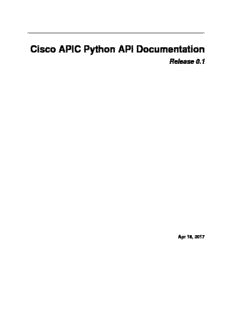Table Of ContentCisco APIC Python API Documentation
Release 0.1
Jul 02, 2020
Contents
1 UnderstandingtheCiscoApplicationPolicyInfrastructureController 3
2 InstallingtheCiscoAPICPythonSDK 7
3 ViewingthestatusoftheSDKandmodelpackagesinstall 11
4 UninstallingtheCiscoAPICPythonSDK 13
5 Installingpyopenssl 15
6 GettingStartedwiththeCiscoAPICPythonAPI 17
7 APIReference 21
8 Examples 43
9 ToolsforAPIDevelopment 51
10 FrequentlyAskedQuestions 53
11 DownloadCobraSDK 55
12 Indicesandtables 57
PythonModuleIndex 59
Index 61
i
ii
CiscoAPICPythonAPIDocumentation,Release0.1
Contents:
Contents 1
CiscoAPICPythonAPIDocumentation,Release0.1
2 Contents
1
CHAPTER
Understanding the Cisco Application Policy Infrastructure Controller
1.1 Understanding the Cisco Application Policy Infrastructure Con-
troller
TheCiscoApplicationPolicyInfrastructureController(APIC)isakeycomponentofanApplicationCentricInfras-
tructure(ACI),whichdeliversadistributed,scalable,multi-tenantinfrastructurewithexternalend-pointconnectivity
controlledandgroupedviaapplicationcentricpolicies.TheAPICisthekeyarchitecturalcomponentthatistheunified
point of automation, management, monitoring and programmability for the Application Centric Infrastructure. The
APICsupportsthedeployment, managementandmonitoringofanyapplicationanywhere, withaunifiedoperations
modelforphysicalandvirtualcomponentsoftheinfrastructure.
TheAPICprogrammaticallyautomatesnetworkprovisioningandcontrolbasedontheapplicationrequirementsand
policies. It is the central control engine for the broader cloud network, simplifying management while allowing
tremendousflexibilityinhowapplicationnetworksaredefinedandautomated.
1.1.1 ACI Policy Theory
The ACI policy model is an object-oriented model based on promise theory. Promise theory is based on scalable
controlofintelligentobjectsratherthanmoretraditionalimperativemodels, whichcanbethoughtofasatop-down
management system. In this system, the central manager must be aware of both the configuration commands of
underlyingobjectsandthecurrentstateofthoseobjects. Promisetheory,incontrast,reliesontheunderlyingobjects
tohandleconfigurationstatechangesinitiatedbythecontrolsystemitselfas“desiredstatechanges.”Theobjectsare
then responsible for passing exceptions or faults back to the control system. This approach reduces the burden and
complexity of the control system and allows greater scale. This system scales further by allowing the methods of
underlyingobjectstorequeststatechangesfromoneanotherandfromlower-levelobjects.
Withinthistheoreticalmodel,ACIbuildsanobjectmodelforthedeploymentofapplications,withtheapplicationsas
thecentralfocus.Traditionally,applicationshavebeenrestrictedbythecapabilitiesofthenetworkandbyrequirements
topreventmisuseoftheconstructstoimplementpolicy. Conceptssuchasaddressing,VLAN,andsecurityhavebeen
tiedtogether,limitingthescaleandmobilityoftheapplication. Asapplicationsarebeingredesignedformobilityand
webscale,thistraditionalapproachhindersrapidandconsistentdeployment. TheACIpolicymodeldoesnotdictate
3
CiscoAPICPythonAPIDocumentation,Release0.1
anythingaboutthestructureoftheunderlyingnetwork. However,asdictatedbypromisetheory,itrequiressomeedge
element,calledaniLeaf,tomanageconnectionstovariousdevices.
1.1.2 Object Model
Atthetoplevel,theACIobjectmodelisbuiltonagroupofoneormoretenants,allowingthenetworkinfrastructure
administrationanddataflowstobesegregated.Tenantscanbeusedforcustomers,businessunits,orgroups,depending
onorganizationalneeds.Forinstance,anenterprisemayuseonetenantfortheentireorganization,andacloudprovider
mayhavecustomersthatuseoneormoretenantstorepresenttheirorganizations. Tenantscanbefurtherdividedinto
contexts,whichdirectlyrelatetoVirtualRoutingandForwarding(VRF)instances,orseparateIPspaces. Eachtenant
can have one or more contexts, depending on the business needs of that tenant. Contexts provide a way to further
separatetheorganizationalandforwardingrequirementsforagiventenant. Becausecontextsuseseparateforwarding
instances,IPaddressingcanbeduplicatedinseparatecontextsformultitenancy.
Withinthecontext,themodelprovidesaseriesofobjectsthatdefinetheapplication. Theseobjectsareendpoints(EP)
and endpoint groups (EPGs) and the policies that define their relationship. Note that policies in this case are more
thanjustasetofaccesscontrollists(ACLs)andincludeacollectionofinboundandoutboundfilters, trafficquality
settings,markingrules,andredirectionrules. ThecombinationofEPGsandthepoliciesthatdefinetheirinteraction
isanApplicationNetworkProfileintheACImodel.
1.1.3 Understanding the Management Information Tree
The Management Information Tree (MIT) consists of hierarchically organized MOs that allow you to manage the
APIC.EachnodeinthistreeisanMOandeachhasauniquedistinguishedname(DN)thatidentifiestheMOandits
placeinthetree. EachMOismodeledasaLinuxdirectorythatcontainsallpropertiesinanMOfileandallchildMOs
assubdirectories.
1.1.4 Understanding Managed Objects
TheAPICsystemconfigurationandstatearemodeledasacollectionofmanagedobjects(MOs),whichareabstract
representationsofaphysicalorlogicalentitythatcontainasetofconfigurationsandproperties. Forexample,servers,
chassis,I/Ocards,andprocessorsarephysicalentitiesrepresentedasMOs;resourcepools,userroles,serviceprofiles,
andpoliciesarelogicalentitiesrepresentedasMOs. ConfigurationofthesysteminvolvescreatingMOs,associating
themwithotherMOs,andmodifyingtheirproperties.
At runtime all MOs are organized in a tree structure called the Management Information Tree, providing structured
andconsistentaccesstoallMOsinthesystem.
1.1.5 Endpoint Groups
EPGsareacollectionofsimilarendpointsrepresentinganapplicationtierorsetofservices. Theyprovidealogical
grouping of objects that require similar policy. For example, an EPG could be the group of components that make
up an application’s web tier. Endpoints are defined using the network interface card (NIC), virtual NIC (vNIC), IP
address,orDomainNameSystem(DNS)name,withextensibilitytosupportfuturemethodsofidentifyingapplication
components.
EPGs are also used to represent entities such as outside networks, network services, security devices, and network
storage. EPGsarecollectionsofoneormoreendpointsthatprovideasimilarfunction. Theyarealogicalgrouping
withavarietyofuseoptions,dependingontheapplicationdeploymentmodelinuse.
4 Chapter1. UnderstandingtheCiscoApplicationPolicyInfrastructureController
CiscoAPICPythonAPIDocumentation,Release0.1
1.1.6 Endpoint Group Relationships
EPGsaredesignedforflexibility,allowingtheirusetobetailoredtooneormoredeploymentmodelsthatthecustomer
can choose. The EPGs are then used to define the elements to which policy is applied. Within the network fabric,
policyisappliedbetweenEPGs,thereforedefiningthewaythatEPGscommunicatewithoneanother. Thisapproach
isdesignedtobeextensibleinthefuturetopolicyapplicationwithintheEPGs.
HerearesomeexamplesofEPGuse:
• EPGdefinedbytraditionalnetworkVLANs: AllendpointsconnectedtoagivenVLANplacedinanEPG
• EPGdefinedbyVirtualExtensibleLAN(VXLAN):SameasforVLANsexceptusingVXLAN
• EPGmappedtoaVMwareportgroup
• EPGdefinedbyIPorsubnet: forexample,172.168.10.10or172.168.10
• EPGdefinedbyDNSnamesorDNSranges: forinstance,example.foo.comor*.web.foo.com
The use of EPGs is both flexible and extensible. The model is intended to provide tools to build an application
networkmodelthatmapstotheactualenvironment’sdeploymentmodel.Thedefinitionofendpointsalsoisextensible,
providing support for future product enhancements and industry requirements. The EPG model offers a number of
management advantages. It offers a single object with uniform policy to higher-level automation and orchestration
tools. Tools need not operate on individual endpoints to modify policies. Additionally, it helps ensure consistency
acrossendpointsinthesamegroupregardlessoftheirplacementinthenetwork.
1.1.7 Policy Enforcement
TherelationshipbetweenEPGsandpoliciescanbethoughtofasamatrixwithoneaxisrepresentingthesourceEPG
(sEPG)andtheotherrepresentingthedestinationEPG(dEPG.)Oneormorepolicieswillbeplacedattheintersection
oftheappropriatesEPGsanddEPGs. ThematrixwillbesparselypopulatedinmostcasesbecausemanyEPGshave
noneedtocommunicatewithoneanother.
Policiesaredividedbyfiltersforqualityofservice(QoS),accesscontrol,serviceinsertion,etc.Filtersarespecificrules
forthepolicybetweentwoEPGs. Filtersconsistofinboundandoutboundrules: permit,deny,redirect,log,copy,and
mark. Policiesallowwildcardfunctionsinthedefinitions. Policyenforcementtypicallyusesamost-specific-match-
firstapproach.
1.1.8 Application Network Profiles
AnApplicationNetworkProfileisacollectionofEPGs,theirconnections,andthepoliciesthatdefinethoseconnec-
tions. Application Network Profiles are the logical representation of an application and its interdependencies in the
networkfabric. ApplicationNetworkProfilesaredesignedtobemodeledinalogicalwaythatmatchesthewaythat
applicationsaredesignedanddeployed. Theconfigurationandenforcementofpoliciesandconnectivityishandledby
thesystemratherthanmanuallybyanadministrator.
ThesegeneralstepsarerequiredtocreateanApplicationNetworkProfile:
1. CreateEPGs(asdiscussedearlier).
2. Createpoliciesthatdefineconnectivitywiththeserules:
• Permit
• Deny
• Log
• Mark
1.1. UnderstandingtheCiscoApplicationPolicyInfrastructureController 5
CiscoAPICPythonAPIDocumentation,Release0.1
• Redirect
• Copy
3. CreateconnectionpointsbetweenEPGsusingpolicyconstructsknownascontracts.
1.1.9 Contracts
Contractsdefineinboundandoutboundpermit,deny,andQoSrulesandpoliciessuchasredirect.Contractsallowboth
simpleandcomplexdefinitionofthewaythatanEPGcommunicateswithotherEPGs,dependingontherequirements
of the environment. Although contracts are enforced between EPGs, they are connected to EPGs using provider-
consumerrelationships. Essentially,oneEPGprovidesacontract,andotherEPGsconsumethatcontract.
The provider-consumer model is useful for a number of purposes. It offers a natural way to attach a “shield” or
“membrane”toanapplicationtierthatdictatesthewaythatthetierinteractswithotherpartsofanapplication. For
example,awebservermayofferHTTPandHTTPS,sothewebservercanbewrappedinacontractthatallowsonly
theseservices. Additionally,thecontractprovider-consumermodelpromotessecuritybyallowingsimple,consistent
policyupdatestoasinglepolicyobjectratherthantomultiplelinksthatacontractmayrepresent. Contractsalsooffer
simplicitybyallowingpoliciestobedefinedonceandreusedmanytimes.
1.1.10 Application Network Profile
ThethreetiersofawebapplicationdefinedbyEPGconnectivityandthecontractsconstituteanApplicationNetwork
Profile.Contractsalsoprovidereusabilityandpolicyconsistencyforservicesthattypicallycommunicatewithmultiple
EPGs.
1.1.11 Configuration Options
TheCiscoApplicationPolicyInfrastructureController(APIC)supportsmultipleconfigurationmethods,includinga
GUI,aRESTAPI,aPythonAPI,Bashscripting,andacommand-lineinterface.
1.1.12 Understanding Python
Pythonisapowerfulprogramminglanguagethatallowsyoutoquicklybuildapplicationstohelpsupportyournetwork.
Formoreinformation,see‘http:www.python.org<http://www.python.org>’
1.1.13 Understanding the Python API
ThePythonAPIprovidesaPythonprogramminginterfacetotheunderlyingRESTAPI,allowingyoutodevelopyour
ownapplicationstocontroltheAPICandthenetworkfabric,enablinggreaterflexibilityininfrastructureautomation,
management,monitoringandprogrammability.
ThePythonAPIsupportsPythonversions2.7and3.4.
1.1.14 Understanding the REST API
The APIC REST API is a programmatic interface to the APIC that uses a Representational State Transfer (REST)
architecture. TheAPIacceptsandreturnsHTTPorHTTPSmessagesthatcontainJavaScriptObjectNotation(JSON)
orExtensibleMarkupLanguage(XML)documents.Youcanuseanyprogramminglanguagetogeneratethemessages
andtheJSONorXMLdocumentsthatcontaintheAPImethodsormanagedobject(MO)descriptions.
FormoreinformationabouttheAPICRESTAPI,seetheAPICRESTAPIUserGuide.
6 Chapter1. UnderstandingtheCiscoApplicationPolicyInfrastructureController
Description:Cisco APIC Python API Documentation, Release 0.1 on organizational needs. For instance, an enterprise may use one tenant for the entire organization, and a cloud provider

